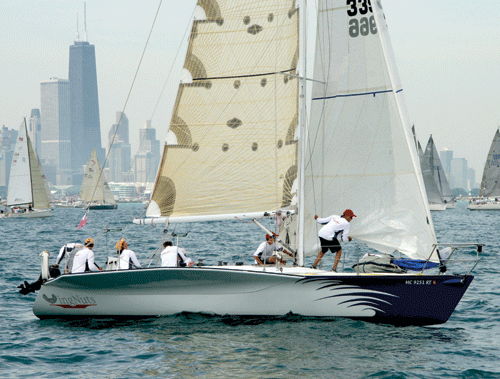Unstable boat design blamed in Chicago-Mac deaths
Race committee, safety requirements lauded in independent panel report
The boat that capsized in the 2011 Chicago-Mackinac Race, leading to the deaths of two sailors, was unsuitable for sailing in an offshore distance race on Lake Michigan, an independent review panel appointed by U.S. Sailing said in a report submitted in October.
The panel said the Kiwi 35 Wingnuts was "highly inappropriate for a race of this duration, overnight, without safety boats in an area known to have frequent, violent thunderstorms" in its findings. Mark Morley, 51, and Suzanne Bickel, 41, died after Wingnuts capsized in northern Lake Michigan during a storm July 17. The pair were trapped under the overturned hull and, according to the coroner's report, died of head injuries.

Wingnuts, one of eight Kiwi 35s built, is an unconventional design, with wings that extend from the narrow hull. Its limit of positive stability-a figure that indicates a boat's resistance to capsize-is 107 degrees, meaning that if it heels 108 degrees it will capsize, while a typical 35-foot keelboat has an LPG index of between 110 and 120 degrees, according to the report. In addition to that, the wings create additional instability, according to yacht designer Jim Teeters, who consulted with the panel.
"The wings are low buoyancy and with one wing sticking into the water and another wing up in the air, the boat ends up tripping over the wing all while the wing in the air adds windage," Teeters said. "The crew was expecting the boat to come back up because they've been there before. But the boat is so light and with all that windage, she just went the rest of the way."
Chicago Yacht Club, which organizes the annual 333-mile race, had stability requirements only for 21- to 26-foot boats sailing in the Doublehanded division, which were required to have a minimum stability index of 110 degrees.
The panel found that Wingnuts was in compliance with all safety requirements for the race with the exception of one harness tether that did not have a shackle on the chest end. Tethers are required to have shackles at both ends. This hindered a crewmember from releasing himself after the capsize but both Morley and Bickel were wearing compliant tethers.
The story of the capsize outlined in the report and based on interviews with the Wingnuts crew is chilling account of an accident that happened in the blink of an eye. Peter Morley, co-owner of Wingnuts and brother of Mark Morley, said as the boat went past 90 degrees he yelled, "It's going over. Everybody get clear of the boat!" Mark Morley and Bickel were thrown together to the end of their tethers onto the leeward wing, suffering severe injuries to their heads and faces. Sixteen-year-old Christopher Cummings was dragged underwater unable to unhook his tether and Peter's son Stuart Morley, 15, swam down to release his cousin's tether.
Crewmember Stan Dent was under the hull in an air pocket created by the cockpit and opted not to inflate his manual-inflating PFD until later. He unclipped his tether at the jackline end but as he tried to swim out from under the boat, the dragging tether got tangled and he used a multitool to cut it away. After climbing on the wing, he saw Bickel underwater and grabbed her shoulder, but there was no response. He went back to the transom where Peter Morley was hanging on, cut his tether, and returned, but did no longer saw Bickel. John Dent, Stan's cousin, was down below when the boat capsized and swam out aft without a life jacket. None of the crew saw Mark Morley after the capsize.
Still in the water while the rest of the crew was on the overturned hull, Peter looked for his brother and Bickel. He found Bickel and considered attempting to revive her but realized it was too late. Meanwhile, the two teenage sailors activated the SPOT Messaging Devices they carried, one of which sent a text message with the boat's position to his mother's cell phone. The crew then started signalling with lights and whistles, which is when the crew on the Beneteau 40.7 Sociable, another boat competing in the race, found the boat and rescued the remaining crew.
The panel stressed that sailors should not give up on time-tested safety precautions such as the wearing of harnesses and inflatable PFDs because of the incident.
"This was a bizarre accident and it's really a rare occurrence to have people end up on the wrong side of the deck," said Chuck Hawley who led the panel. "My great concern is that people will think tethers or high buoyancy PFDs are bad. We have to be very careful that we don't look at an obscure incident and move away from time-tested equipment."
The panel also said that the safety regulations in place for the race worked well for the fleet but recommended that half of the boats in each division or class are inspected prior to the race and that infractions found in post-race inspections be penalized and publicized.
"We'd like to see them put more teeth in the post-race inspections and see boats that fail be heavily penalized," Hawley said.
Members of the panel said it was important to note the Wingnuts tragedy was an extremely unusual occurrence in an event that had never had an accident-related fatality in 102 previous races.
"A lot of boats got knocked over and all but one came back up," Teeters said. That's a pretty strong testament to the stability of the boats and the expertise of the crews sailing them."

Comments